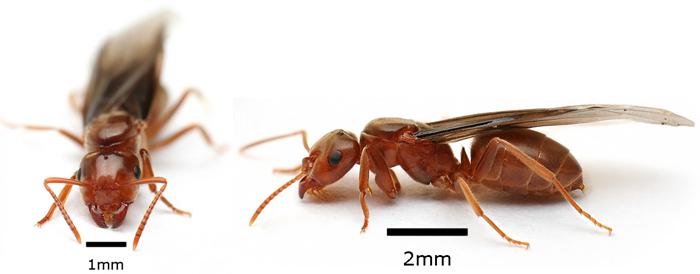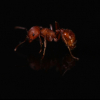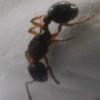- Formiculture.com
- Forums
- Gallery
- Members
- Member Map
- Chat

Queen ID Chesterfield,Virginia
Started By
AntTeen804
, May 6 2015 3:29 PM
30 replies to this topic
#21
 Offline
-
Posted May 6 2015 - 6:12 PM
Offline
-
Posted May 6 2015 - 6:12 PM
I'll go check tomorrow then.Thanks.
If you ain't got a dream, you ain't got nothing.
#22
 Offline
-
Posted May 6 2015 - 6:13 PM
Offline
-
Posted May 6 2015 - 6:13 PM
No prob.
#23
 Offline
-
Posted May 6 2015 - 6:51 PM
Offline
-
Posted May 6 2015 - 6:51 PM
Looks like a parasitic Lasius to me.
See if you can find any Lasius pupae and put them with her. Or try to introduce one adult worker to her (having the worker chilled in the fridge is easier - but the queen should not be chilled). If she kills one worker, try a second (from the same colony), as some Lasius parasites will kill one worker to gain the scent of the colony.
Feed her once a day with a small drop of sugar water on a tinfoil plate, she will likely eat some.
But get a better picture of her mandibles.
Polyergus are quite unmistakable - huge scythes like this - 
Parasitic Lasius have more shovel shaped mandibles like this - 
"Always do right. This will gratify some people, and astound the rest." -- Samuel Clemens
#24
 Offline
-
Posted May 7 2015 - 1:43 AM
Offline
-
Posted May 7 2015 - 1:43 AM
She looks just like that but lighter red.
If you ain't got a dream, you ain't got nothing.
#25
 Offline
-
Posted May 7 2015 - 8:21 AM
Offline
-
Posted May 7 2015 - 8:21 AM
It is not the color you are looking at - color can vary widely.
You are looking at the shape of the mandibles - the jaws.
I showed pictures of two different ant species in my previous post.
- AntTeen804 likes this
"Always do right. This will gratify some people, and astound the rest." -- Samuel Clemens
#26
 Offline
-
Posted May 7 2015 - 11:51 AM
Offline
-
Posted May 7 2015 - 11:51 AM
Parasitic Lasius sp. I didn't know they make founding chambers?
#27
 Offline
-
Posted May 7 2015 - 12:02 PM
Offline
-
Posted May 7 2015 - 12:02 PM
check the description as well.
#28
 Offline
-
Posted May 7 2015 - 12:13 PM
Offline
-
Posted May 7 2015 - 12:13 PM
As I thought.
#29
 Offline
-
Posted May 7 2015 - 12:17 PM
Offline
-
Posted May 7 2015 - 12:17 PM
The point is that they will sometimes hibernate in a chamber, then infiltrate a colony in spring.
#30
 Offline
-
Posted May 7 2015 - 4:50 PM
Offline
-
Posted May 7 2015 - 4:50 PM
It failed so I just let her go.
If you ain't got a dream, you ain't got nothing.
#31
 Offline
-
Posted December 14 2015 - 12:18 PM
Offline
-
Posted December 14 2015 - 12:18 PM
I've been going through records of Lasius interjectus sightings, and if there's one thing I have learned, it's that this is one of the only Lasius species (maybe the only one, I don't know, I haven't looked into it) in the US that regularly flies in May. I would imagine L. interjectus was the correct ID for this queen.
1 user(s) are reading this topic
0 members, 1 guests, 0 anonymous users

















